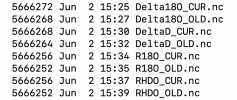littledddna@gmail_com
Member
Dear all,
I have a question about doing a branch run using iCESM. I have managed to create new CLM data by adding tracer variables, HOWEVER, when i try to run the model, it seems that POP also needs deltaO18 in its restart file. So, How can I add it to the restart file? Can I simply use add it using iCESM restart files provided at iCESM1.2 restart file from "The Connected Isotopic Water Cycle in the Community Earth System Model Version 1" ?
Thanks very much
X
I have a question about doing a branch run using iCESM. I have managed to create new CLM data by adding tracer variables, HOWEVER, when i try to run the model, it seems that POP also needs deltaO18 in its restart file. So, How can I add it to the restart file? Can I simply use add it using iCESM restart files provided at iCESM1.2 restart file from "The Connected Isotopic Water Cycle in the Community Earth System Model Version 1" ?
Thanks very much
X

